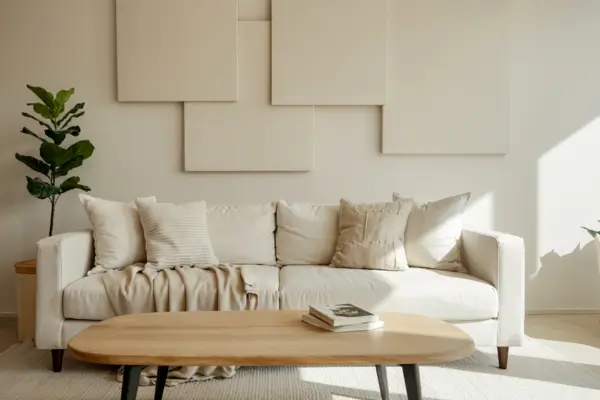We often focus on how our homes look—color palettes, textures, furniture, and lighting—but how our homes sound is just as important. Acoustic design is the missing link in many interiors, yet it plays a huge role in how calm, comfortable, and livable a space feels. Unwanted noise from traffic, appliances, echoes, or even footsteps can trigger stress and reduce a sense of well-being. Fortunately, creating a quieter and more serene home doesn’t require building a recording studio. With smart choices in materials, layout, and furnishings, you can reduce noise and improve sound quality in any space. In this article, we’ll explore the principles of acoustic design and share practical, stylish tips to help you cultivate a more peaceful atmosphere at home—one sound decision at a time.
Why Acoustics Matter in Interior Design
Sound is invisible, but it shapes our experience of a space just as much as sight or touch. Acoustics affect how we concentrate, rest, interact, and feel emotionally. A room with poor sound absorption can feel chaotic and draining, while one with good acoustic balance can feel calm and inviting. The goal of acoustic design is not total silence, but rather sound control—reducing noise where it’s intrusive and enhancing sound where it brings comfort or clarity. For example, a quiet bedroom supports better sleep, while a balanced living room enhances conversation. Understanding these dynamics allows you to create interiors that not only look good but feel good to live in.
The Science Behind Sound in Rooms
Sound travels in waves, bouncing off surfaces and filling a room with either pleasing resonance or disturbing echoes. Hard materials like tile, concrete, or glass reflect sound, increasing noise levels. Soft materials like fabric, rugs, and upholstered furniture absorb sound, helping to dampen it. The arrangement and materials of walls, floors, ceilings, and objects all influence how sound behaves. Even ceiling height and room shape affect acoustic quality. By understanding how sound waves interact with surfaces, you can make design decisions that improve the auditory experience of your home.
Emotional and Health Benefits of a Quieter Home
Noise pollution doesn’t just irritate—it affects health. Prolonged exposure to unwanted sound can elevate stress hormones, disrupt sleep, and impair concentration. On the other hand, quieter environments support relaxation, emotional regulation, and better sleep quality. In shared homes or apartments, sound control can also help reduce conflict and increase privacy. Investing in acoustic design is, in essence, an investment in your mental and emotional well-being.
Common Noise Sources and How to Address Them
Before improving acoustics, it’s important to identify where the noise comes from. Common sources include outside traffic, upstairs neighbors, humming appliances, thin walls, hollow floors, and large echo-prone rooms. Once you’ve pinpointed the problems, you can tailor your acoustic strategy. In many cases, simple upgrades can make a noticeable difference. Let’s look at the most common noise issues and what you can do about them.
Outdoor Noise: Windows and Walls
Traffic noise and street sounds are among the most common disturbances, especially in urban settings. Replacing single-pane windows with double-glazed versions can reduce noise dramatically. Adding heavy curtains or window inserts also helps block external sounds. For walls, installing acoustic panels or adding bookshelves filled with books creates mass that muffles outside noise. These solutions improve comfort without compromising style.
Interior Noise: Floors, Doors, and Echo
Footsteps, appliance hums, and voices can travel easily through hard surfaces. Carpets or large rugs with thick underpads help absorb floor noise, especially in upstairs rooms. Replacing hollow doors with solid-core ones can block sound between rooms. To reduce echo in open-plan spaces, use acoustic panels, wall hangings, upholstered furniture, and even large indoor plants to scatter and soften sound waves.
Materials That Improve Acoustic Comfort
Choosing the right materials is key to improving acoustics without sacrificing aesthetics. Some of the most effective sound-absorbing materials are already part of cozy, stylish decor. By layering these materials, you reduce unwanted sound reflections and soften the overall auditory experience. Let’s break down the best materials to use in each part of your home.
Walls: Acoustic Panels and Soft Wall Treatments
Fabric-covered acoustic panels are highly effective at reducing echo and background noise. You can find stylish options that blend in as decorative features. Alternatively, wall tapestries, fabric wall hangings, cork panels, or even strategically placed artwork can help break up sound waves and absorb excess reverberation. Painted foam panels can also add color and texture while improving sound quality.
Floors: Rugs, Carpets, and Underlays
Hard flooring surfaces like tile and hardwood reflect sound, while soft flooring absorbs it. Adding thick area rugs or wall-to-wall carpeting greatly reduces footstep noise and echo. For even better results, use padded underlays beneath rugs or carpet—this added layer improves both comfort and sound insulation. Choose dense, woven materials like wool or felt for maximum effect.
Ceilings: Acoustic Tiles and Softening Strategies
Ceilings are often overlooked in acoustic design, but they play a major role in echo control. Acoustic ceiling tiles, often used in offices and studios, can also be adapted for stylish home use. For a more decorative approach, consider suspended ceiling panels, fabric canopies, or wood slats that help diffuse sound. Vaulted ceilings benefit from added texture, such as wooden beams or textured paint finishes.
Acoustic Design Room by Room
Each room in your home has its own sound profile and acoustic needs. A tailored approach ensures that every space supports the activities and mood you want to cultivate. Here’s how to approach acoustic comfort in the most important areas of your home.
Living Room: Balance and Conversation
The living room often hosts conversation, entertainment, and relaxation. Use soft furnishings—sofas, cushions, drapes—and add layered rugs to balance sound. Avoid bare walls and minimalistic layouts that create echo. A bookshelf, media console, or textile wall art can act as sound diffusers while enhancing style.
Bedroom: Silence for Sleep
Silence is essential for restful sleep. Start by blocking outdoor noise with double-glazed windows and blackout curtains. Place a large rug under the bed and use upholstered headboards to absorb sound. Avoid electronics or appliances with humming sounds. For shared walls, consider adding an acoustic panel or tall bookshelf between rooms.
Home Office: Focus and Privacy
In a home office, sound clarity and privacy are crucial. Solid doors, thick curtains, and wall-mounted acoustic panels create a focused environment. If you attend virtual meetings, place rugs under your chair and behind your desk to absorb background noise and reduce echo. A bookshelf or soft divider can also provide a buffer from household sounds.
Simple, Stylish Additions That Make a Difference
You don’t need a renovation budget to enhance your home’s acoustics. Small adjustments can deliver big results. Swapping out a glass coffee table for a wooden one, adding a fabric wall hanging, or even using more throw pillows can subtly reduce noise. Indoor plants are surprisingly effective too—their leaves absorb sound and add life to any room. Acoustic design doesn’t have to look technical; it can blend seamlessly into your aesthetic.
Conclusion
Good acoustic design isn’t just about blocking noise—it’s about creating calm, comfort, and emotional ease within your space. When our homes sound better, they feel better. A quieter environment reduces stress, promotes deeper rest, and enhances daily activities like work, conversation, and relaxation.
Whether you live in a bustling city apartment or a quiet suburb, unwanted noise can sneak in—but thoughtful acoustic choices help restore harmony. From layering rugs and curtains to adding wall panels or soft furnishings, each step creates a home that soothes rather than stimulates. Even simple changes can bring powerful improvements without compromising your aesthetic.
Ultimately, sound is a form of invisible design—one that deserves just as much attention as color or texture. By tuning into the acoustic qualities of your home, you make space for peace, presence, and well-being. Because when your surroundings support your serenity, every day becomes just a little bit better.




